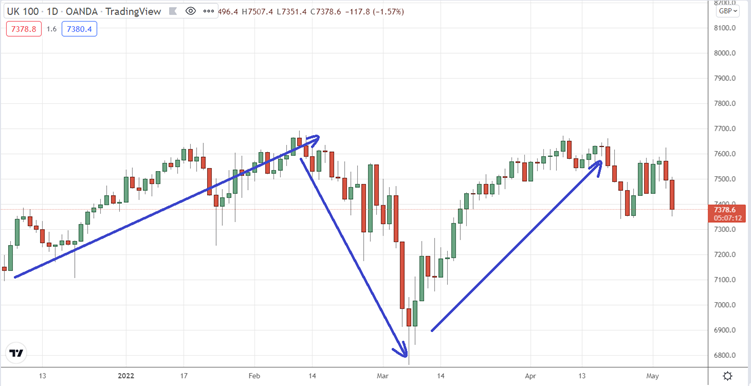As you learn how to trade, it’s important to understand that the way financial markets move up and down is the result of participants buying and selling. If there is a greater volume of buyers, the price of the market will go up as buyers are forced to pay higher prices to encourage sellers to sell. If there are more sellers than buyers, the price will go down. 
For investors looking for capital growth over the medium to long term (rather than an income), the main aim is to buy an asset at one price and sell it later for a higher price. If they can do that, investors make a capital gain or profit. If these investors sell it for a lower price than they bought it, of course they lose money.
How traders can profit from short-term moves
It’s the same idea for short-term traders, who buy into a market they believe will go up and then sell out of it when it has gone up for a profit. See our Trading For Beginners guide here for more on learning how to trade.
Going on past performance, it’s widely accepted that over the long-term stock markets tend to rise. In fact, stocks are seen as the best performing asset over the long term, especially when you factor in the dividends that many companies pay out to their shareholders on a regular basis.
That’s why, when it comes to shares, it’s natural to think only about buying them or ‘going long’ to profit if the price rises. It’s not always the case though. If a share is trading at a price above what is justified by its underlying value – in other words, that it is overvalued, traders might want to take a position to profit from the share price falling in the future.
How to profit from falling prices
This is known as short selling (or ‘shorting’). Since the advent of spread betting and contracts for difference (CFDs), it is very easy for retail traders and investors to do, as you will see in a moment.
Short trading example
Before that, to give the idea some context, let us look at the ‘traditional’ way of short selling.
Let’s say you don’t like the (fictional) company, AceBrill. You’ve seen the way the company is trading, read about the outlook for the sector and you’ve heard negative stories about it. You expect the company to have some bad results and you believe the share price is going to fall.
So, before spread betting and CFDs existed (and you can still do this now), here’s what investors would do.
You’d SELL some AceBrill shares with your broker at price A, and the proceeds would be in your brokerage account.
Normally, when selling traditional shares, you have the settlement period, usually 3 days (although extended settlements can be arranged), to send the shares or certificate to the exchange, otherwise shares will need to be borrowed. For each day the SHORT is not closed after the settlement date, a late fee is charged by the exchange, which covers the cost of borrowing.
Closing your short trade
If the company’s results were indeed bad and the shares fell, you could BUY back the same number of shares at the lower price, B. The difference between price A and price B was your profit.
If you were wrong and the share price went up, the difference between what you bought and sold the shares at would be your loss on the trade.
Rather than BUYING something first and then SELLING at a higher price to make a profit, with short selling, you’re SELLING something first and then BUYING it back at a lower price to make a profit.
A great strategy for traders when prices are falling
Given that markets move up and down, you can understand why people might want to make such bets on share prices falling. The ability to bet on falling prices effectively doubles the opportunities to make a profit.
Spread betting makes short selling easy
With spread betting and CFDs, shorting is easier to do. With spread betting, you can bet that AceBrill is going to fall. You place a ‘down bet’ or SELL at your chosen amount per point, e.g. £3 per point. Then, when you want to close out the bet or trade, you just BUY it back. (Just another click of the mouse.)
How to calculate profits on a trade
One spread betting point for most UK shares is equal to one pence. So, if the price of AceBrill was to fall from 650p to 450p, that’s a move of 200 points. Trading at £3 per point, you would make £600 profit.
Of course, if you got the trade wrong and the share went UP 200 points, you’d LOSE £600.
Interesting to note that when spread betting UK shares, £1 per point is the exact trade size to 100 shares or 100 CFDs. Other than dealing cost differences, the profit and loss on £1 and 100 shares would be the same.
The point is though, with spread betting it is easy to short sell shares. And it’s the same for a stock index, a forex pair like EUR/USD (Euro versus US dollar) or a commodity like gold or oil.
Shorting the forex markets
If you think the European Central Bank is going to slash interest rates but the US Federal Reserve is going to hold theirs steady, you can easily bet on the price of the Euro falling against the dollar by shorting EUR/USD.
If you think that the FTSE or the Dow is going to FALL, you can just place a down bet or SELL it.
When you’re ready, you just click a button to close the trade. Or set an automatic order to close it when it hits your target... or your stop loss. The difference between your entry price and your closing price is your profit or loss.
Learning how to short sell gives an important and powerful tool to have in your trading toolkit in any environment, especially when the prevailing trend is down. You can read more about short selling in this Investopedia article.
At Trendsignal, our indicators identify both long (buy) and short (sell) trade opportunities so that we can look to profit in all market conditions.
To learn more about short selling , I’d like to invite you to join a free webinar where we’ll demonstrate our proprietary trading tools and tell you more about our coaching programme. We run these webinars through the week and so there is a choice of times for you to attend a session.
The sessions are free to attend, you simply need to register here and then we’ll send you a confirmation email with your personal access link for the session and instructions of how to join at your chosen time.
I look forward to welcoming you to the session and showing you more about our trading strategies and courses.
If you’d like to view more of our courses click here
If you’d like to access more of our guides and e-books click here.







